SDN has moved again!
Subscribe to our RUMBLE channel
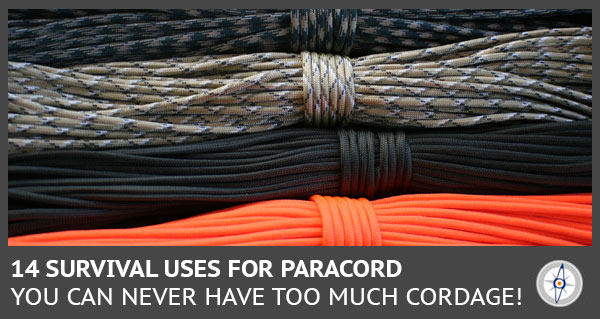
When you find yourself in a fighting for survival in the wilderness, there are a few tools that are tough to build yourself. It is difficult to build a knife blade, it is difficult to build a fire starter, it is difficult to build a truly waterproof shelter, and it is difficult to build cordage.
You can use fiborous plants tree roots to make cordage, but it is not ideal. Cordage made from natural materials is not as strong, not as flexible, and is very time consuming to make. Therefore, having quality cordage with you is very important for wilderness survival (or any situation for that matter).
There are several types of cordage that you can take into the wild. Conventional braided rope and twine are cheap, but can fray and wear out quicker than other options. Nylon rope is stronger and more weather resistant, but tends to flex and is more expensive. Climbing rope is very strong and durable, but is so expensive that I really never want to cut it.
Your best option is 550 paracord. This cordage is very thin, but incredibly strong. It has seven (or more) interior strands and is rated to hold 550 pounds of pressure. You can remove the interior strands, and each one is strong enough to use by itself. If you can bring 550 paracord with you into the wilderness, you will always have a huge advantage.
Ways to Carry Paracord
While I like to include a spool of 250 feet of paracord with me in my pack, sometimes that is not an option. Paracord is important enough as a survival tool that I like to find several ways to carry it with me in my Every Day Carry kit (EDC) as well.
This means I have found ways to carry paracord 24 hours, 7 days a week with no exceptions. My favorite way to carry paracord is to replace my boot and shoe laces with paracord. You can simply melt the ends of your cut cordage and they work just like laces.
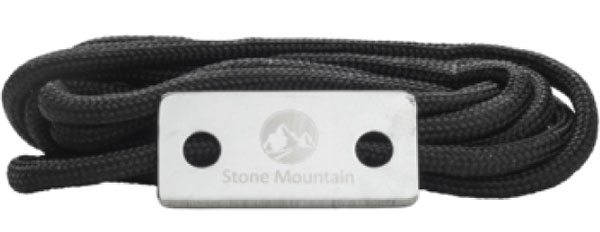
If I split apart my boot laces and use the interior strands, I have almost 100 feet of cordage just from my laces.
Lanyards, bracelets, and paracord grenades are also good options to make sure you always have some paracord with you. You can buy these items or make them yourself. I keep a paracord bracelet around my ankle that has almost 50 feet of cordage along with a ferro rod, a compass, and a signal whistle.
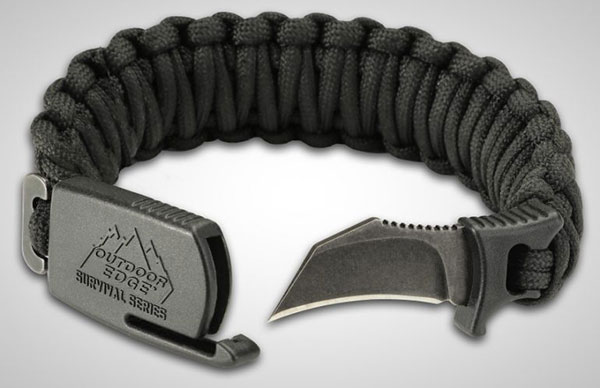
I have a lanyard attached to my EDC filter water bottle that has another 50 feet of cordage. Paracord grenades are typically a bundle of small survival supplies or a self-defense ball bearing wrapped with woven paracord. All of these options allow me to keep lots of cordage with me all the time.
Alternative Survival Paracord
As paracord has become more popular in the survival community, some companies have designed paracord with additional purposes.
The paracord I have in one of my boots still has seven interior strands, but they are coated with a flammable material. In addition, the tips have ferro rods and there is a striker laced on them as well. This is perfect for starting fire in wet weather and still having paracord for other purposes.
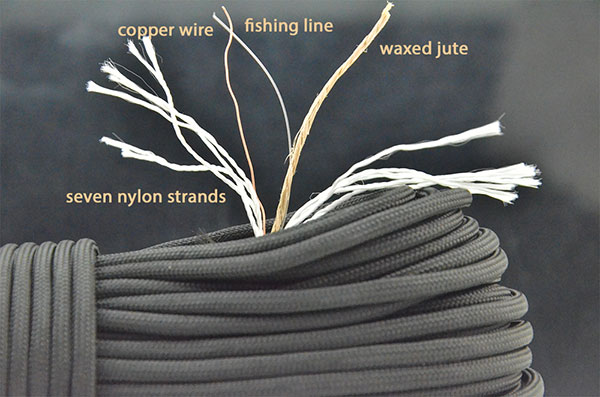
I have also seen paracord that has a length of fishing line, a length of copper wire, and a length of flammable material (jute) along with the other strands needed for strength. This allows one to fish, trap, and start fire with their paracord.
14 Survival Uses for Paracord
There are countless uses for paracord in a survival scenario. Here are some of the ways that I personally have used 550 paracord during my survival challenges.
1. Building Primitive Shelters
While I have gotten better at building shelters without cordage, you will always have a more stable shelter with cordage. I typically use the full paracord for securing heavier poles such as ridge poles. Then I use the interior strands to secure anything smaller and lighter.
2. Raising a Bear Bag
When you have any type of food in the wild, you have to be concerned about predators coming into your camp to check it out. This is especially true for bears as they can smell your food from up to 20 miles away. They are happy to rip through a shelter looking for an easy snack.
Even if you are not in bear country, other animals can be just as aggressive. Secure your food in a bundle and use paracord to raise it up into a tree at least 10 feet above the ground. Your bear bag should be around 100 feet from your camp.
3. Fishing
The interior strands of paracord are strong enough for fishing for just about any type of fish. You can use it as a hand line, attach it to a pole, make a trot line, or even weave a gill net if you have the patience. This gives you a variety of ways to catch fish actively or passively so you have the protein you need to survive. You can also use paracord to stringer your fish and keep them fresh longer, but always stringer through the bottom lip and not the gills.
4. Trapping
The interior strands of paracord are good for making snare traps for small animals. You simply tie a loop in one end, feed the other end through the loop, and you have a slip knot.
You can then attach it to something secure and place the snare vertically so a small animal would walk their head right through the center. You may have to use sticks to keep the snare upright. Check your traps once or twice a day to ensure the animal does not chew its way free. See this article on primitive trapping for more information.
5. Making Tools
One of the practices that can give you an advantage in the wild is if you take the time to build tools. One example of this is attaching a sharp rock or knife blade to the end of a pole to create a spear.
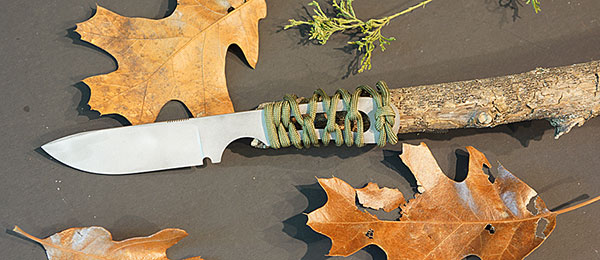
To do this you will want to carve out the end of the pole so the sharp object fits in the center. Then use the interior strands to tightly wrap around both the pole and the point to secure it in place. Tie it off with a clove hitch knot, and you are all set.
6. Making a Bow Drill Kit
One of the most widely taught methods for starting fire in the wild is using a bow drill kit. The reason is that you can build one using mostly natural materials if you do not have another way to start a fire.
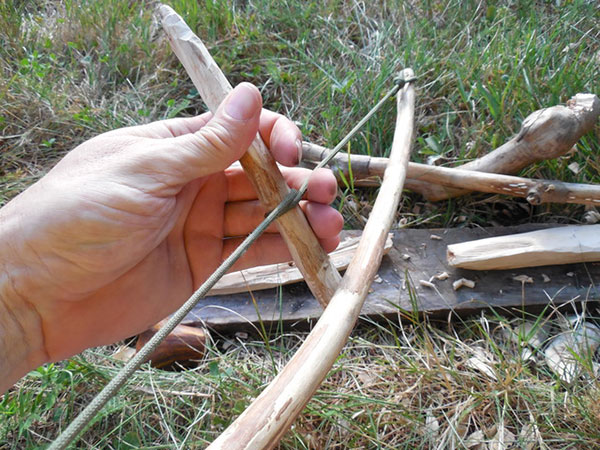
The key is having strong cordage for the bow. It is very difficult to make cordage that is strong enough, but a length of un-split paracord is perfect for this.
7. Marking your Tools
Early on in my survival career, I was scouting an area for food and my ferro rod fell out of my pocket. I had no other way to start fire, and could not find the small piece of metal.
I have also had times when I set down knives and other tools only to lose track of where I set them. Based on these experiences, I started buying hunter orange paracord and tying a small loop to the handle of all my tools. This loop also allows me to keep a tighter grip on hatchets, saws, and machetes that could slip out of my hand.
8. First Aid
You never know what might happen to you physically when you are attempting to survive. You can use whole strands of paracord for tourniquets, for securing splints, or for keeping limbs elevated above the heart. You can use the individual interior strands for securing bandages or even for sewing stitches if needed.
9. Cloth Repairs
The interior strands of paracord can be used to repair clothing, packs, or even tarps. You just have to have a needle large enough for the strand, or a way to make a small hole in the fabric before feeding the cordage through.
10. Cooking
For cooking over a fire, paracord can help in a few ways. You can use paracord to put up a tripod over your fire. From there you can tie a pot or bottle above the fire to cook. You can also use paracord to create a grate above the fire for cooking meat or vegetables.
11. Tarp or Emergency Blanket Shelter
If you are lucky enough to have a tarp or emergency blanket with you, you can turn it into a perfect waterproof shelter. An A-frame design is typically best for this.
Stretch a full strand of paracord between two trees about 10 feet apart and tie it as tightly as possible about four feet off of the ground. Drape your tarp or emergency blanket over the paracord.
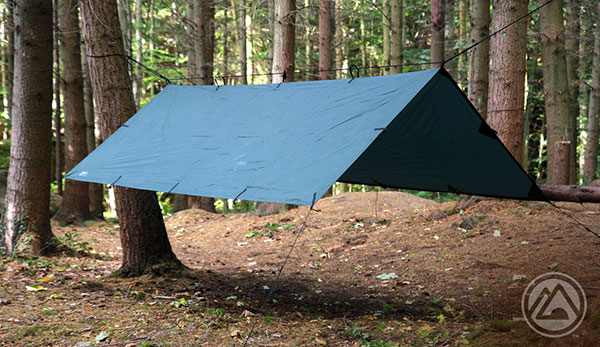
If the tarp or emergency blanket has grommets at the corners, then tie on full strands of paracord and secure the corners to rocks or wooden stakes. The finished product should be pulled tight. If the blanket has no grommets, place small stones in the corners and tie around the stones.
12. Climbing
While 550 paracord is a bit thin for ideal climbing, it will hold a grown man’s weight. It will not hold up against much of a fall, so you must keep the cord tight (no slack). Your best bet is to tie loops every few feet in the cordage so you have a sturdy handhold or foothold. It is not perfect, but must safer than free-climbing.
13. Bundling Firewood
One of the most labor intensive tasks you have in the wilderness is collecting firewood. This task becomes much easier if you are able to bundle it together versus holding it together with your arms.
I like to create a snare with a full strand and pull it tight around one side of the bundle. Then I pull it to the other side and wrap it underneath to tie off back at the top. This gives me a bit of a handle in the middle to throw the bundle over my shoulder.
14. Perimeter Alert System
To sound an alarm when either animals or other people enter your area, you can use the interior strands to string up a warning line around your camp. You want the string to stretch all the way around your camp and to be lifted two to three feet off the ground with sticks or branches. Then attach a can or bottle with small stones in the bottom so intruders will make noise as they hit the line.
Final Thoughts
While there is always a long list of tools that you want to bring in a wilderness survival scenario, cordage has to be high on that list. As you can see, there are so many uses for strong, multi-strand cordage like paracord that you would never want to do without it.
It can help you secure food, purify water, build shelter, and start a fire. Having a good amount of 550 paracord with you can literally save your life. In addition, it is so easy to carry some with you.
Even if you cannot carry a huge spool in your pack, you can always have some laced in your boots or woven into various other lanyards and bracelets. With all that being said, there is really no excuse for not having quality cordage with you in any survival situation.
=====
Become a Survival Dispatch Insider …
We bring together survival enthusiasts and preppers to share skills and knowledge, so you can enhance your preparedness for emergencies and ensure the safety of you and your community.
The Results You’ll Get …
Our community, courses, and memberships are pretty special. We focus on the ways it will make a huge difference in your life.
Here are a few of the things you’ll be able to do as a member of Survival Dispatch Insider …
1) Improve your emergency preparedness by learning survival skills and strategies from experienced preppers.
2) Build lasting connections with like-minded individuals that share your passion for safety and readiness.
3) Access a wealth of knowledge and resources to assist in protecting you and your community during unexpected situations.
Click HERE to get started.
=====
